Owls are intriguing birds that capture the attention of anyone lucky enough to get a glance at them. There’s more to owls than their eccentric faces and nocturnal habits, though.
These majestic birds boast impeccable low-light vision and precise hearing that allow them to snatch prey in pitch-black darkness. And with the aid of their soft feathered wings, they’re able to fly silently.
Luckily for bird watchers who live in Utah, the state is home to more than 460 species of birds; 14 of which are owls.
If you’re a Utah resident or you plan on visiting the state anytime soon, you should stick around, as we’re about to shed light on the 14 owl species to look for in Utah.
Barn Owl
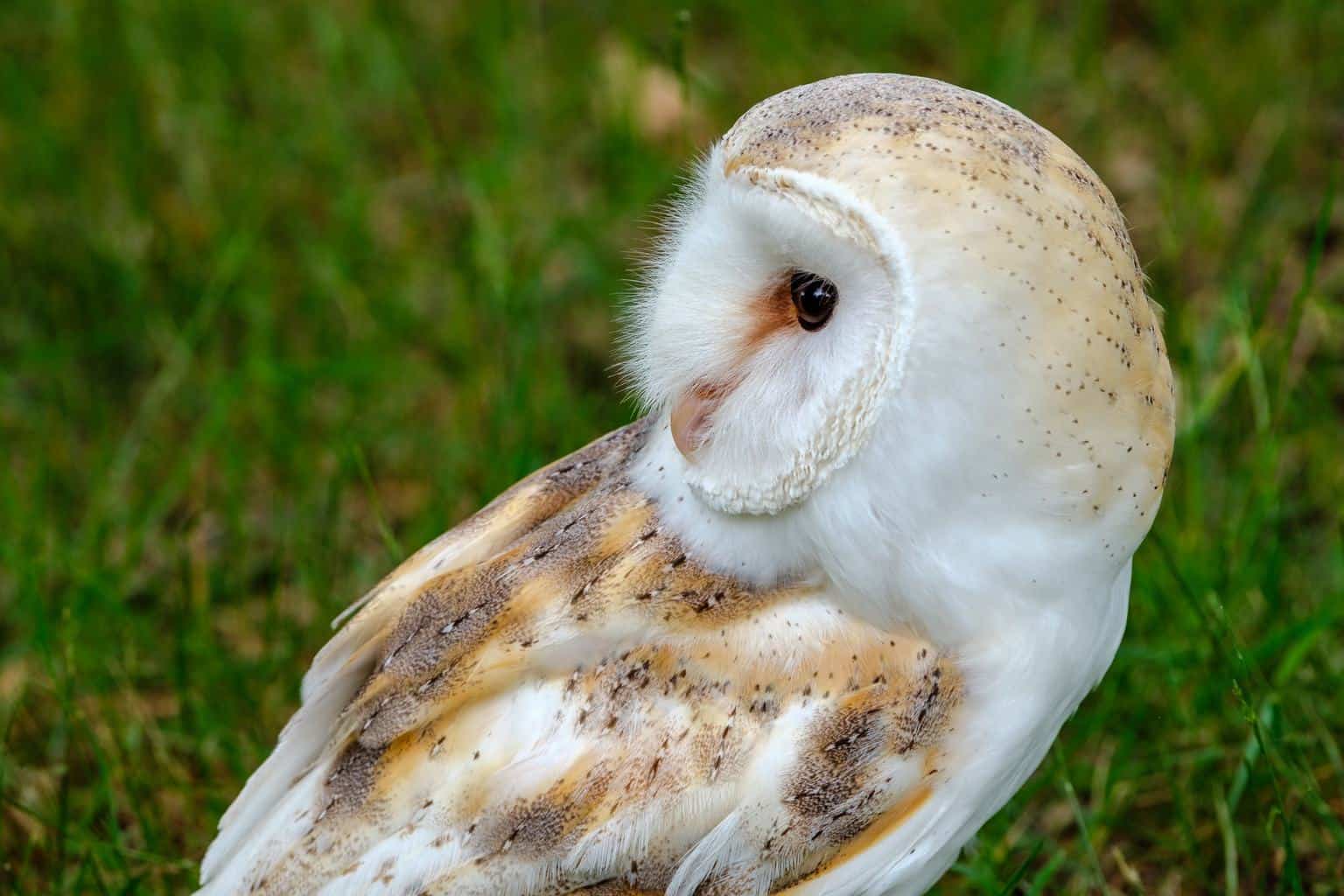
- Scientific Name: Tyto alba
- Length: 12.5 to 16 in
- Weight: 14 to 25 oz
- Wingspan: 30 to 49 in
These owls are easily identified by their white heart-shaped face. Their bodies are pale with a mix of buff and grey on their wings and heads.
Barn owls are profoundly nocturnal. They can be seen hunting during the day only during a food shortage. These dark-eyed owls use their strong hearing sense and their excellent low-light vision to strike their prey in total darkness. A Barn owl hunting is quite a sight.
Their name refers to the fact that they nest in barns and other abandoned structures. You can find them everywhere in Utah. They’re permanent residents of the state. We recommend watching them on the Bear River Migratory Bird Refuge.
Because their favorite food is rodents, many farmers like to have them around. Barn owls swallow their prey whole. Then, they cough up the undigested parts as pellets.
The call of a Barn owl is more like a screech; almost like the sound hawks make. It’s not at all similar to the typical owl sound you hear in movies.
Boreal Owl

- Scientific Name: Aegolius funereus
- Length: 8 to 11 in
- Weight: 3.5 to 7.5 oz
- Wingspan: 21.5 to 24.5 in
Although Boreal owls are permanent residents of the state, they’re a difficult animal to spot and the least spotted by birders. These owls live at high elevations in mixed forests.
These predators prefer coniferous forests where spruce and fir are mixed with deciduous trees. The best places you can spot these birds are the Uinta Mountains, Franklin Basin, and the Beaver Mountain Ski Area.
Boreal owls are small owls with brown bodies. Look for white spots on their wings and brown streaks on their bellies.
These highly nocturnal owls hunt from perches with the aid of their precise hearing. Their prey can’t get away by hiding in snow or under vegetation.
Burrowing Owl

- Scientific Name: Athene cunicularia
- Length: 7.5 to 10 in
- Weight: 4.5 to 9 oz
- Wingspan: 21 to 24 in
Burrowing owls are one of the easiest owl species to identify. They’re long-legged and mottled brown, with pale spots all over their upperparts.
Burrowing owls have unique white throats and eyebrows. They’re called “Burrowing” because they inhabit underground burrows abandoned by prairie dogs and other animals.
You’ve probably seen these owls before. They’re the most frequently spotted as they, unlike other owls, hunt on the ground during the day.
You’ll also find them in abundance living in man-made burrows on Antelope Island State Park. These small owls like to store extra food in their burrows for days when food is scarce.
Elf Owl
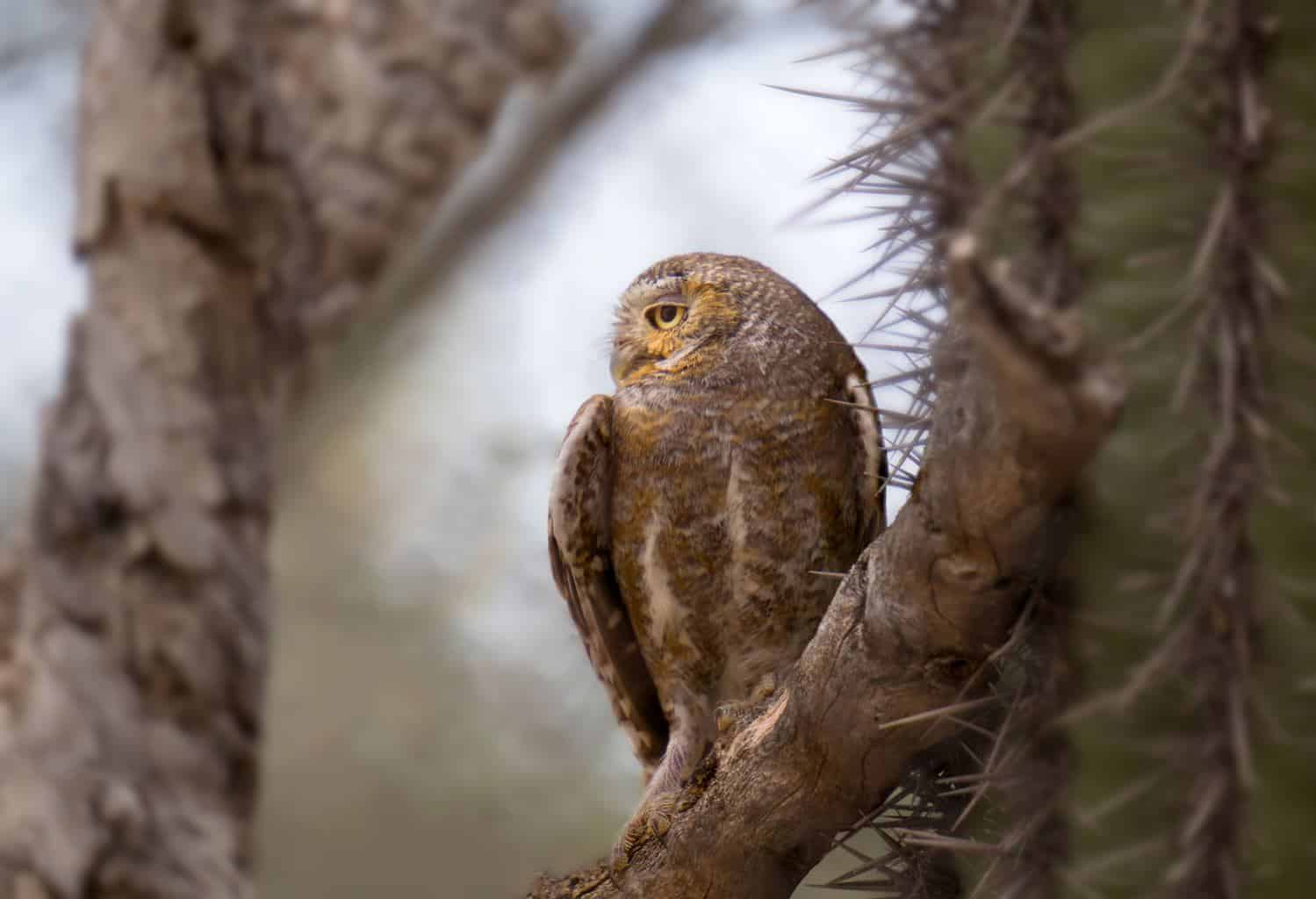
- Scientific Name: Micrathene whitneyi
- Length: 5 to 6 in
- Weight: 1.5 to 2 oz
- Wingspan: 13.5 to 16.5 in
These are the smallest owls on the whole continent. They weigh less than a tennis ball. Elf Owls feed mostly on insects and scorpions. Sometimes they catch small lizards and snakes, too.
These tiny owls are greyish brown with pale yellow eyes highlighted by white eyebrows. Their round heads have no feathers or ear tufts.
You can spot Elf Owls in a couple of locations; on Beaver Dam Wash or Lytle Ranch, but keep in mind that they only hunt at night or near dusk.
These birds aren’t aggressive at all. They’ll play dead until the threat is gone. These highly vocal owls migrate south to Mexico in late winter when insects are scarce.
Elf owls inhibit abandoned woodpeckers’ holes and natural cavities in riparian areas or areas with plenty of saguaro cactus.
Flammulated Owl
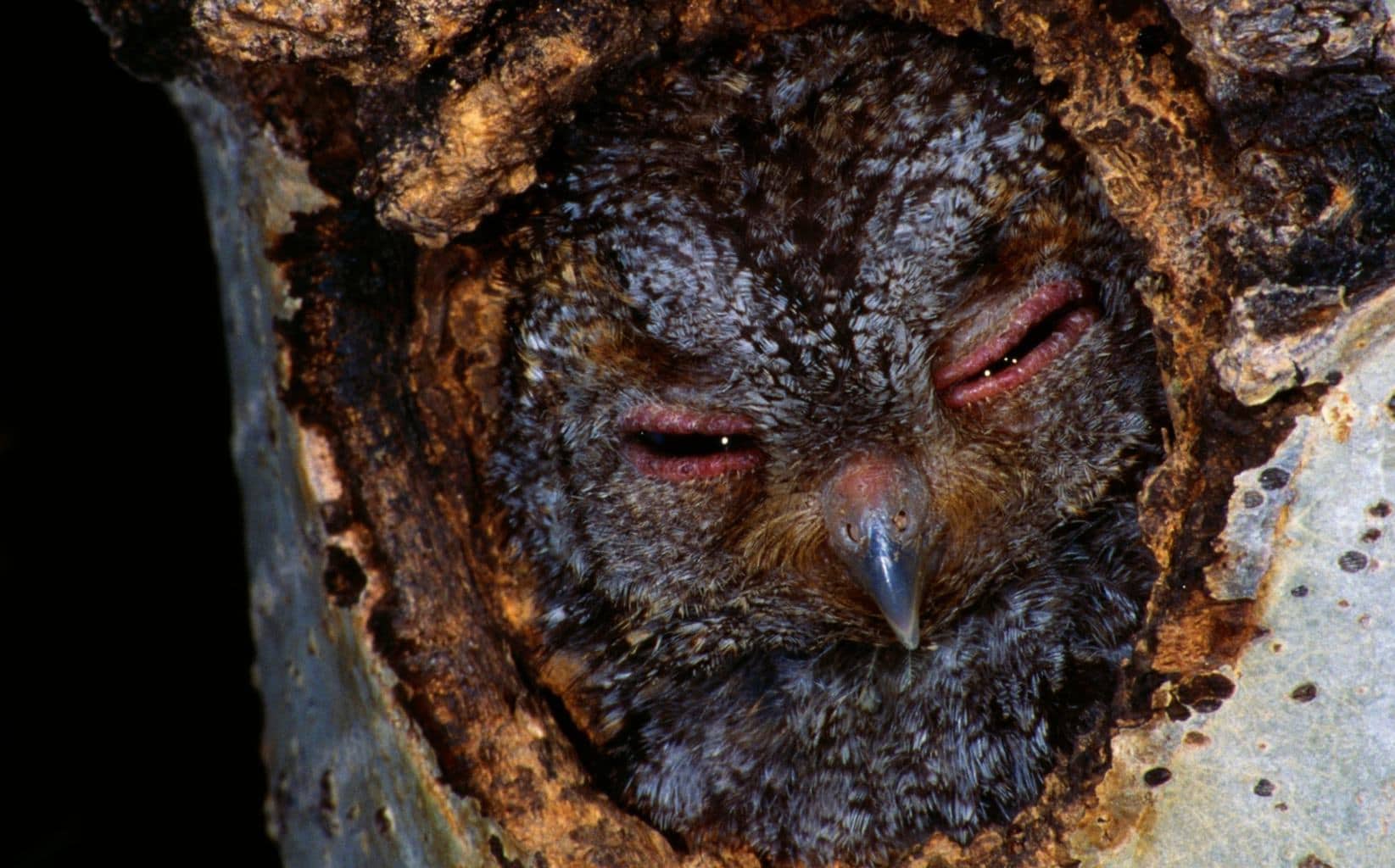
- Scientific Name: Psiloscops flammeolus
- Length: 6 to 7 in
- Weight: 1.5 to 2.5 oz
- Wingspan: 16 to 16.5 in
These small owls are the hardest to spot. Their brown and grey plumage helps them camouflage well.
They prefer foraging for insects at the tops of large trees in coniferous and mixed hardwood forests.
Just like the Elf Owls, Flammulated Owls are highly migratory. They spend their winter in Mexico and Central America.
The easiest way to find them is by listening for their deep, low-pitched call. They sound larger and scarier than they really are, an advantage when you’re so small.
Great Gray Owl

- Scientific Name: Strix nebulosa
- Length: 24 to 33 in
- Weight: 24.5 to 60 oz
- Wingspan: 54 to 60 in
This species of owl is one of the tallest and largest owls, but not the heftiest in terms of weight. Great Gray owls have silvery-grey plumage with brown strikes and a unique white “X” between their eyes.
It’s rare to see these owls in Utah. They live and breed in Alaska and Canada and migrate only when food is scarce.
Despite being lightweight, Great Gray owls are one of the strongest types of owls. They can break through hard ice to capture prey. Because of their large size, they might need to eat multiple times a day. When in Utah, these owls feed on pocket gophers, mice, squirrels, and small birds.
Great Horned Owl
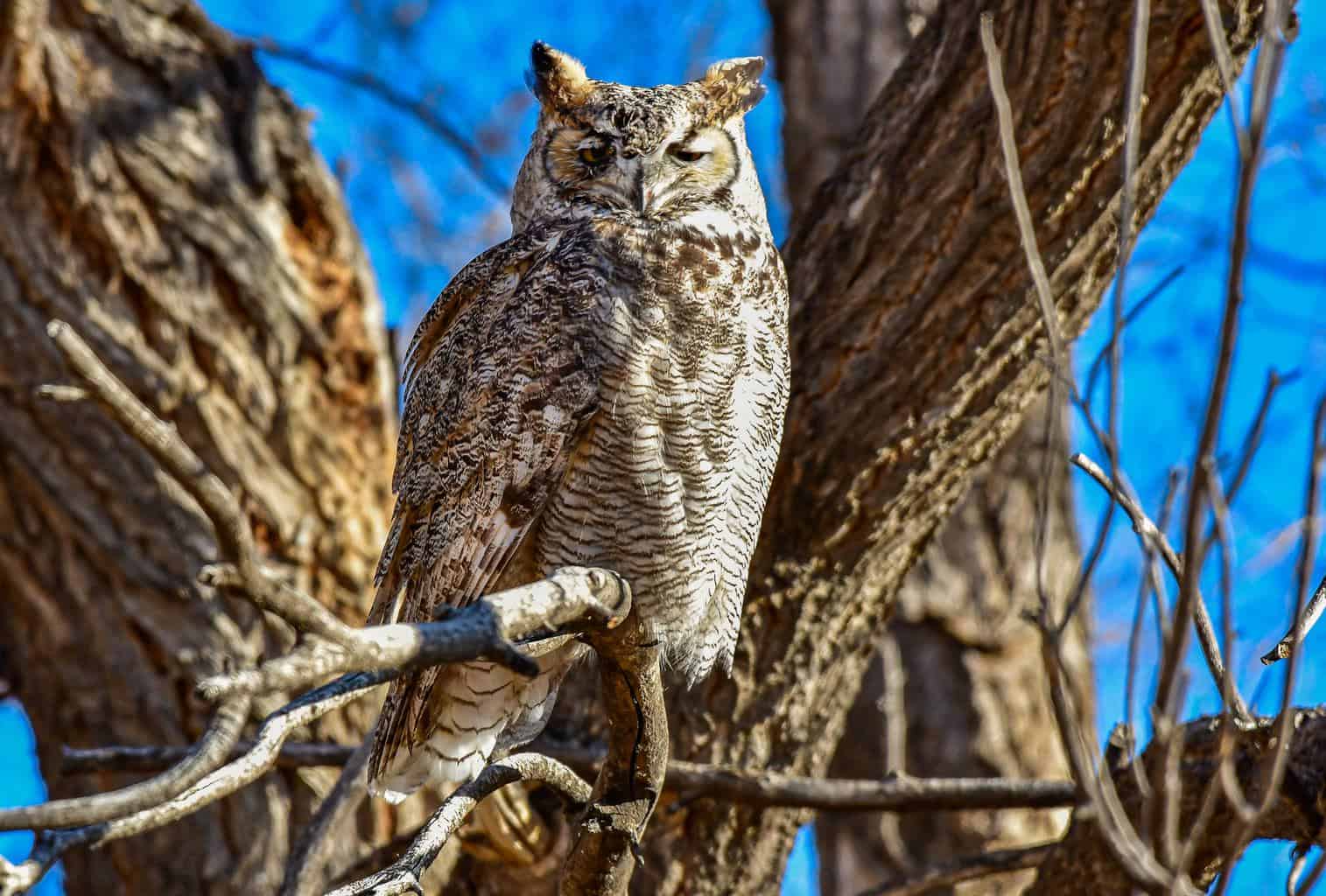
- Scientific Name: Bubo virginianus
- Length: 18 to 25 in
- Weight: 32 to 88 oz
- Wingspan: 40 to 57 in
These are common in Utah and everywhere in North America. They have mottled gray-brown plumage with reddish-brown faces. With their ear tufts, deep hoot, and their intimidating yellow-eyed stare, Great Horned owls are one of the scariest owls. They’re the typical owls of storybooks.
These powerful predators have a variable diet depending on where they are. Their diet ranges from larger animals like Ospreys to small mice.
With their soft feathers, they’re also well adapted to all weather. Bear River Migratory Bird Refuge and Antelope Island State Park are both great places to spot a Horned owl nest.
Long-Eared Owl

- Scientific Name: Asio otus
- Length: 13 to 16 in
- Weight: 8 to 15 oz
- Wingspan: 35.5 to 39.5 in
One of the easiest owls to identify, thanks to the long tufts of feathers over their ears, Long-eared owls have somewhat dark plumage with long and narrow orange facial disks.
These birds are common in Utah but rarely seen. They’re nocturnal creatures that like to roost in the dense foliage where they’re well camouflaged.
Similar to Barn Owls, these predators swallow their prey whole. Then, they regurgitate the indigestible parts in the form of pellets.
The Long-eared owl is pretty vocal. A male’s hoot can be heard from almost a mile away.
Short-Eared Owl

- Scientific Name: Asio flammeus
- Length: 13.5 to 17 in
- Weight: 7.5 to 17 oz
- Wingspan: 33.5 to 40.5 in
These owls are some of the most widespread and most seen in daylight. You can find them where open grasslands and fields are available. Don’t look for their short ears. They’re actually not very visible. Instead, look for mid-sized owls that have distinctive yellow eyes outlined with black color.
Short-eared owls are diurnal owls. They hunt by flying low over the ground and hovering before attacking the prey.
Females are reluctant to leave an active nest. If necessary, they’ll poop on their eggs to draw off predators.
The best places to spot these animals are on the large grasslands on Forest Street near the Bear River Migratory Bird Refuge and the Golden Spike National Historic Park.
Northern Saw-Whet Owl

- Scientific Name: Aegolius acadicus
- Length: 7 to 8.5 in
- Weight: 2.5 to 5.5 oz
- Wingspan: 16.5 to 19 in
This cute owl is easy to identify by its catlike faces. It’s a tiny owl with mottled brown plumage and a distinctive white “V” mark above its eyes. The Northern Saw-whet owl is hard to spot because it’s a nocturnal bird. Also, its plumage helps them camouflage well, so you really have to pay attention to determine its exact location.
These raptors prefer hunting from perches, mostly for small rodents. Males do all the hunting while females take care of the young and keep the nest clean.
These cute little owls have a call that sounds like sharpening or whetting a saw, hence the name. They’re common year-round in Utah, except in the northern part of the state.
Mexican Spotted Owl
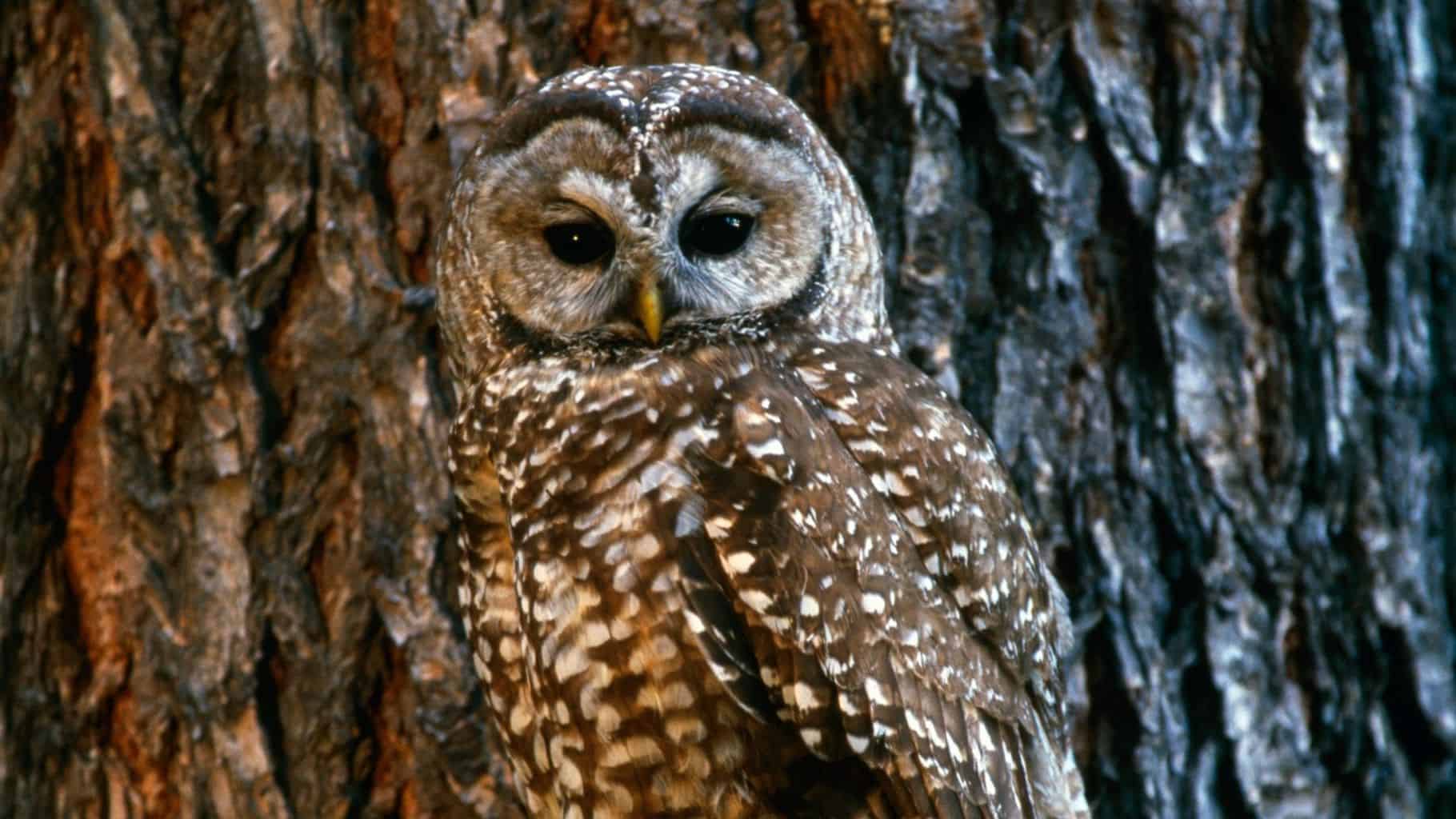
- Scientific Name: Strix occidentalis
- Length: 18.5 to 19 in
- Weight: 17.5 to 25 oz
- Wingspan: 40 to 48 in
These large owls are dark brown overall with oval white marks on their under parts. They’re very distinctive with their dark eyes and the white “X” between them. Spotted owls, along with their three subspecies, are listed as endangered birds due to habitat loss. They need old mature forests for nesting and hunting.
Mexican Spotted owls are the subspecies of Spotted owls found in Utah. These are nocturnal birds that feed mostly on flying squirrels and woodrats.
When a spotted owl catches larger prey than it can eat, it’ll cache food in niches. To memorize its location, it sits upright and looks at it while slowly backing up on foot.
Northern Pygmy-Owl

- Scientific Name: Glaucidium gnoma
- Length: 6 to 7 in
- Weight: 2 to 2.5 oz
- Wingspan: 14.5 to 15 in
Northern Pygmy owl might be a tiny owl, but it is a fearless predator. It can take down prey three times larger than itself.
These are small brown owls with white under parts. They have white speckles on their heads and white spots on their upper parts.
These owls fool their predators, or mobbers, with the aid of the two dark eyespots they have on the back of their necks. They also raise their ear tufts high when sensing a threat.
These diurnal owls have a taste for songbirds. That’s why you’ll find them being mobbed by a group of songbirds defending their own.
Snowy Owl
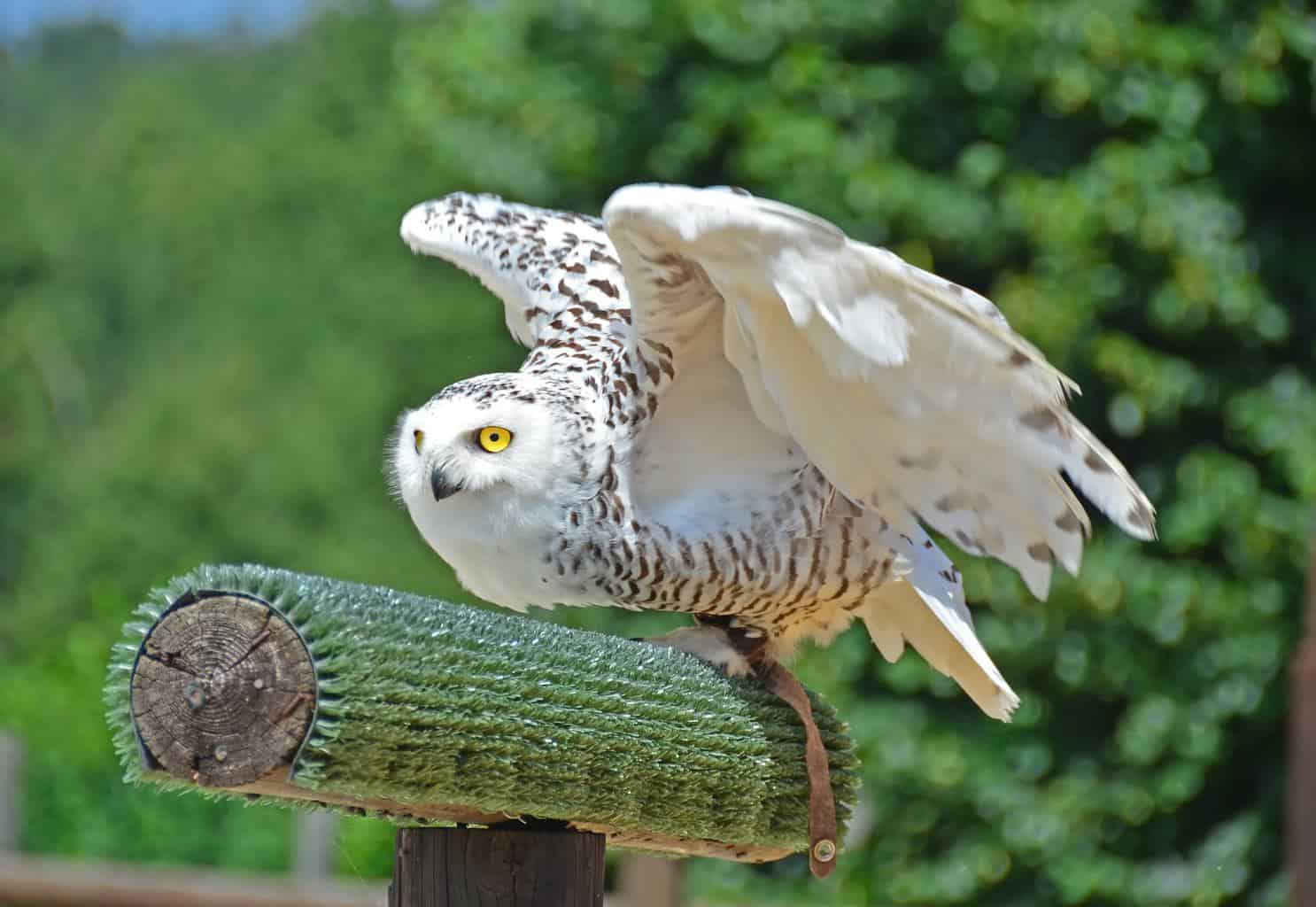
- Scientific Name: Bubo scandiacus
- Length: 20.5 to 28 in
- Weight: 56.5 to 104 oz
- Wingspan: 49.5 to 57 in
This amazing bird is of the most beautiful owls in the world. They’re also some of the heaviest. These beautiful owls are white overall with varying black markings. Harry Potter fans know the Snowy owl by the name Hedwig.
These white owls migrate in winter from Canada to the northern United States. They rarely migrate to Utah, though.
Snowy Owls are extremely diurnal, unlike typical owls. They hunt by perching for lemmings and other mammals.
Western Screech Owl

- Scientific Name: Megascops kennicottii
- Length: 7.5 to 10 in
- Weight: 3.5 to 11 oz
- Wingspan: 21.5 to 24.5 in
Western Screech owls are common residents of the state. They’re found in forests with high trees and also in parks and residential areas.
These are small owls with semi-square heads, no neck, and short ear tufts. Their plumage ranges from brownish to greyish, making them well-camouflaged birds.
These nocturnal animals have a varying diet according to the region in which they live. Their diet includes small mammals, birds, and large insects.
Although they’re called Western Screech owls, their hoot isn’t really a screech. It’s more of an accelerating quiet trill.
Final Thoughts
Utah is an accommodating home for many birds of prey, including owls. Sadly, most of the owl species we know today are listed as endangered birds due to habitat loss.
One of the ways you can help save owls and keep the joy of bird watching alive is by starting backyard feeding. You can also make a donation for organizations like Wild Utah Project and Red Cliffs Audubon.

